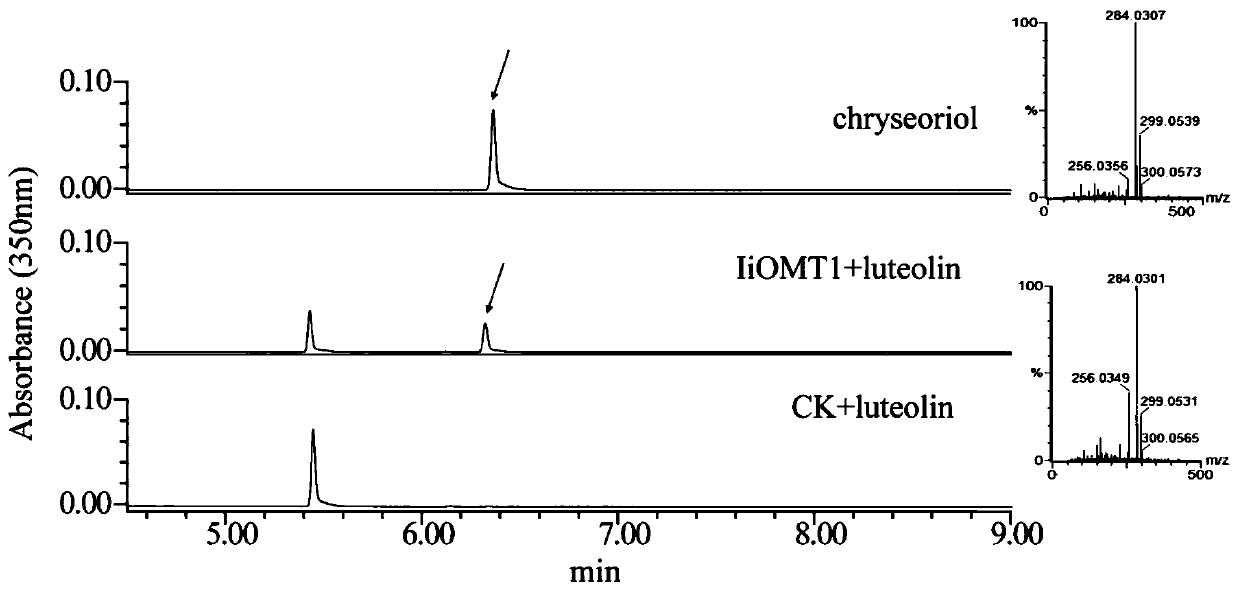Plant flavone methyltransferase protein as well as encoding gene and application thereof
A plant and encoding technology, applied in the field of protein IiOMT1 and its encoding gene and application, can solve the problem that the encoding gene has not been identified
- Summary
- Abstract
- Description
- Claims
- Application Information
AI Technical Summary
Problems solved by technology
Method used
Image
Examples
Embodiment 1
[0071] Embodiment 1, the preparation of recombinant methyltransferase
[0072] One, the acquisition of the coding gene (IiOMT1 gene) derived from the methyltransferase of Isatis indigo
[0073] The inventors of the present invention have discovered the coding gene (IiOMT1 gene) of the methyltransferase in Isatis sativa through a large number of experiments. The nucleotide sequence of the IiOMT1 gene is shown as sequence 1 in the sequence listing. The IiOMT1 gene encodes the protein IiOMT1, and the amino acid sequence of the protein IiOMT1 is shown in Sequence 2 in the sequence listing.
[0074]The amino acid sequence of protein IiOMT1 was searched for homology in Non-redundantGenBank CDS translation+PDB+Swissprot database using BLAST program in NCBI database.
[0075] OMT phylogenetic tree (neighbor-joining method) see figure 1 . The results showed that the protein IiOMT1 had high homology with OMT in other species at the amino acid level and had a typical active site doma...
Embodiment 2
[0101] Example 2. Recombinant methyltransferase decomposes luteolin to generate golden eriodictin
[0102] The crude enzyme solution (induced by IPTG) of the recombinant bacteria A prepared in Example 1 was used as the solution to be tested.
[0103] 1. Prepare the reaction system. The reaction system consisted of 300 μL of the solution to be tested, 1.5 μL of luteolin solution (solvent in methanol, concentration 40 mM) and 3 μL S-adenosyl-L-methionine (solvent in methanol, concentration 32 mM).
[0104] 2. Take the reaction system prepared in step 1 and put it in a water bath at 30°C for 12 hours.
[0105] 3. Take the reaction system that has completed step 2, add 2 times the volume of pure methanol (for the purpose of terminating the reaction), and shake to extract.
[0106] 4. After completing step 3, centrifuge at 13000rpm for 15min and collect the supernatant.
[0107] 5. After completing step 4, take the supernatant, filter it with a filter membrane with a pore size o...
Embodiment 3
[0114] Example 3. Recombinant methyltransferase decomposes isoorientin to generate auroisogenistein
[0115] The 1.5 μL luteolin solution (solvent is methanol, concentration is 40mM) in embodiment 2 is replaced with 1.5 μL isorientin solution (solvent is methanol, concentration is 40mM); 1-5 are the same, and the filtrate B is obtained.
[0116] The filtrate B and the isogenistein standard were subjected to UPLC (ultra high performance liquid chromatography) analysis.
[0117] UPLC conditions are: chromatographic column: ACQUITY UPLC HSS T3 (2.1mm×50mm, 1.7μm); mobile phase: containing 0.1% formic acid-acetonitrile (A) and containing 0.1% formic acid-water (B); elution gradient: 10 -21%A(0-3min), 35-45%A(5-7min), 55-65%A(9-12min), 95%A(12.5-14min); flow rate: 0.4mL / min; detection wavelength The concentration is 350 nm, the column temperature is 40°C, and the injection volume is 2 μL.
[0118] Experimental results such as Figure 4 As shown, wherein IiOMT1+Isoorientin is th...
PUM
 Login to View More
Login to View More Abstract
Description
Claims
Application Information
 Login to View More
Login to View More - R&D
- Intellectual Property
- Life Sciences
- Materials
- Tech Scout
- Unparalleled Data Quality
- Higher Quality Content
- 60% Fewer Hallucinations
Browse by: Latest US Patents, China's latest patents, Technical Efficacy Thesaurus, Application Domain, Technology Topic, Popular Technical Reports.
© 2025 PatSnap. All rights reserved.Legal|Privacy policy|Modern Slavery Act Transparency Statement|Sitemap|About US| Contact US: help@patsnap.com



